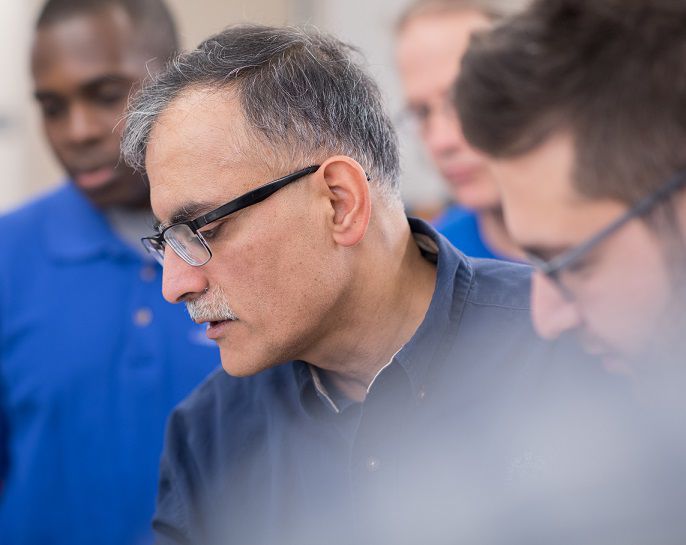Villanovans Launch Low-cost, Open Source Ventilator Initiative to Create “NovaVent” Ventilator
Courtesy of Villanova University
Villanova University College of Engineering Professor Dr. C. Nataraj
April 8, 2020
Ventilators have become a crucial resource in the fight against the novel coronavirus, but strained healthcare systems across the country have been scrambling to secure enough to outpace looming shortages. The virus’ ability to spread rapidly, subsequently increasing the number of hospitalizations, along with the extended period of time many severely ill patients must use the life-saving machine have crippled the availability of these devices.
It has been projected that 960,000 coronavirus patients in the U.S. may require ventilators during the coming months, but estimates suggest there are only about 200,000 of the devices, according to The Society of Critical Care Medicine.
Villanova College of Engineering professor Dr. C. Nataraj, PhD has launched a low-cost ventilator initiative to find a solution. Nataraj has assembled a team of fellow engineering faculty, industry professionals and graduate students from the College of Engineering and the M. Louise Fitzpatrick College of Nursing to work with medical experts from Geisinger Health System and Children’s Hospital of Philadelphia to design, develop, test and validate a low-cost (< $1000) ventilator.
The goal of the project is to design a device that is robust, safe and scalable — in order to produce it in large quantities. The ventilator must also meet the minimum performance requirements for the treatment of COVID-19 patients.
In order to address the situation as quickly as possible and speed up assembly, the team is attempting to use parts readily available in the supply chain and as few sophisticated components as possible. The Fitzpatrick College of Nursing has provided critical supplies needed for testing the designed prototype.
In addition to saving lives, this initiative is also expected to stimulate the local and state economy. To do this, the team is in contact with the Pennsylvania Department of Community and Economic Development to concern the engagement of local industry in the manufacturing and distribution of the finished ventilators.
In terms of a timeline, Nataraj has said the objective is to have a prototype ready and validated by ECRI Institute, located in Plymouth Meeting, by mid-April.
“We are nearly finished with the design and fabrication of the prototype” Nataraj said to The Villanovan on Tuesday, April 6. “We will conduct additional testing on campus tomorrow and then our colleagues at CHOP will perform the required animal testing. We hope to have our device validated by the ECRI Institute by early next week so that we can begin collaborating with the Commonwealth and local industry partners to assemble the NovaVent Ventilator.”
A remarkable aspect of the project, driven by the University’s Augustinian mission, is that the engineering team has decided the complete “NovaVent” design, including the computer codes and assembly instructions, will be open source. This enables anyone, anywhere in the world to make the ventilator rapidly with the same performance and reliability.
One of the graduate nursing students working on this initiative, Emily Hylton, BSN, RN, CCRN provided some insight on why she wanted to get involved and more on her role with the team. She said she reached out to Jodie Szlactha, PhD, RN, CRNA, the director of the Nurse Anesthesia Program at the University to find groups that needed extra help. “While studying has proven more than enough to keep me busy, the thought of the healthcare community struggling during this stressful time left me feeling there must be something more I could do to help,” She said. “Jodie connected Shayla, Lucas and myself with the engineering team to help do our part in positively impacting our community.”
As a graduate nursing student, Hylton and her peers provide critical insight to the team. “Our main role in the project is providing feedback on how the ventilators will work for the bedside nurse,” She said. “We have daily meetings with the team and we contribute general knowledge about managing ventilators at the bedside. We help the team understand how the product would be used as well as appropriate safety measures that will need to be taken when the ventilator is implemented.”
A complete list of the team members and their areas of responsibility can be found below.
Engineering team
Dr. C. Nataraj, Moritz Professor of Engineered Systems, Mechanical Engineering, and director, Villanova Center for the Analytics of Dynamic Systems — team lead, control and modeling, certification, medical liaison
Dr. Alfonso Ortega, James R. Birle Professor of Energy Technology, Mechanical Engineering — fluid system design
Dr. Garrett Clayton, associate professor, Mechanical Engineering, and director, Center for Nonlinear Dynamics & Control — control, sensing, system design
Dr. Sridhar Santhanam, professor and chair, Mechanical Engineering — fabrication
Christopher Townend, Mechanical Engineering lab manager—fabrication
Dr. Frank Ferrese ’06 MSCpE, ’13 PhD, Naval Surface Warfare Center — control, modeling
Dr. Philip Asare, Assistant Professor of Electrical and Computer Engineering, Bucknell University — computer user interface
Medical team
Dr. Mark Poler, Anesthesiologist, Geisinger Health System
Dr. Todd Kilbaugh, Children’s Hospital of Philadelphia
Graduate students
M. Louise Fitzpatrick College of Nursing: Emily Hylton, Lucas Halliday, Shayla Davis
Villanova College of Engineering: Carol Caceres, Felipe Valenzuela, Amir Hassan Abbasi
Administrative
Keith Argue, Assistant Dean of External Relations, College of Engineering











